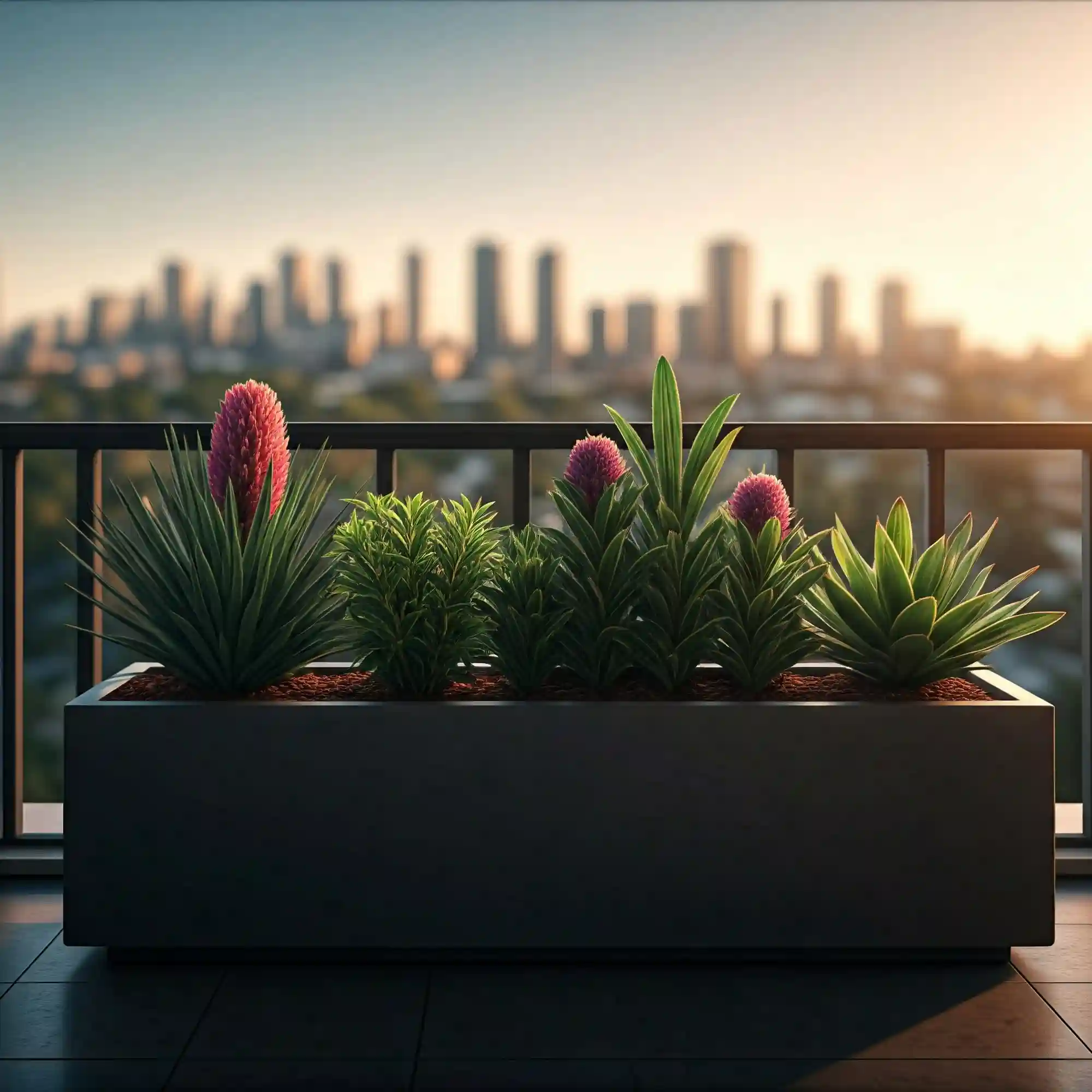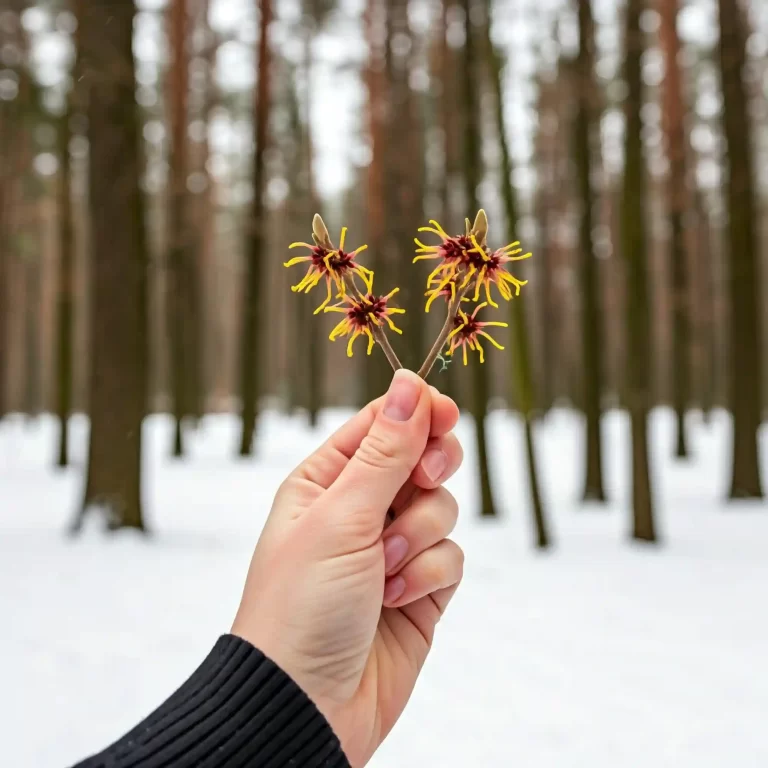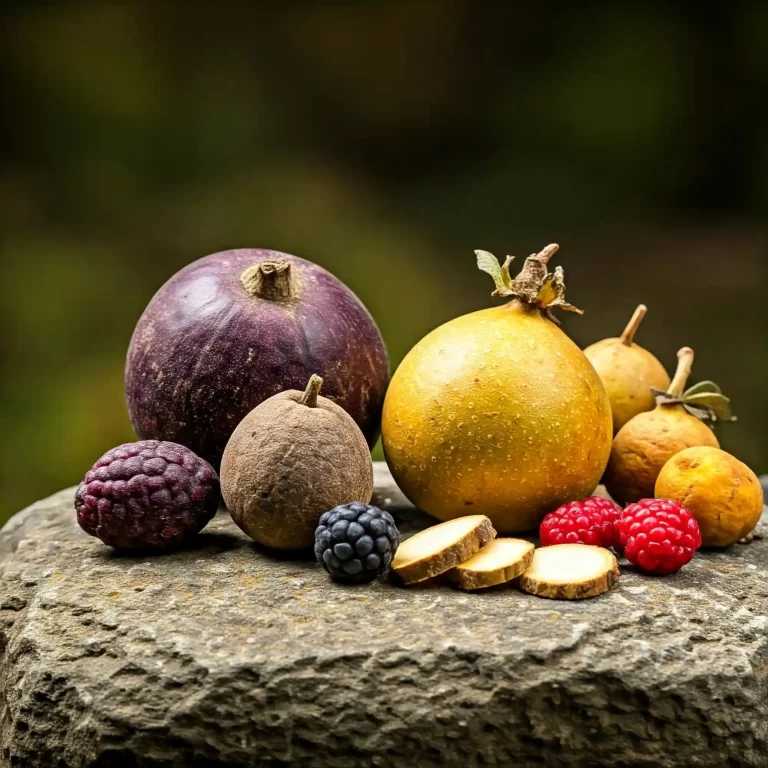Are you dreaming of a vibrant garden bursting with unique Australian flora but limited by space? Do you live in an apartment with a small balcony, a townhouse with a compact courtyard, or simply prefer the versatility of container gardening? I understand the frustration of wanting to connect with nature but feeling constrained by your environment. You’re not alone. Many people, just like you, face this challenge. But there’s a solution: growing Australian native plants in containers. This method allows you to cultivate a slice of the Australian landscape, no matter your space constraints. In this guide, I’ll share my experience and knowledge to help you select the perfect plants, choose the right containers, and provide the care your potted natives need to thrive. Let’s Grow, Plant, Care for Australian Native Plants in Containers.
15 Best Australian Native Plants to Grow in Containers
Now for the exciting part: choosing your plants! I’ve selected 15 Australian native plants that I’ve found to be particularly well-suited to container growing. These plants offer a range of colors, textures, and growth habits, ensuring there’s something for everyone.
1. Grevillea ‘Moonlight’
This stunning Grevillea boasts creamy-white flowers that bloom for most of the year, attracting nectar-loving birds to your garden. It’s relatively compact, making it suitable for medium to large containers.
2. Banksia ‘Birthday Candles’
This dwarf Banksia is a real showstopper, with its vibrant orange-red flower spikes. It’s slow-growing and compact, making it an excellent choice for smaller containers.
3. Correa ‘Marian’s Marvel’
This Correa is a reliable performer, producing masses of pink and red bell-shaped flowers throughout the year. It’s relatively low-maintenance and adaptable to various conditions.
4. Dianella caerulea (Blue Flax-lily)
This versatile plant offers beautiful blue flowers followed by attractive blue berries. It’s drought-tolerant and thrives in a range of conditions, making it a great choice for beginners.
5. Lomandra longifolia (Spiky-headed Mat-rush)
This hardy grass-like plant is perfect for adding texture and structure to your container garden. It’s drought-tolerant and low-maintenance, making it a great choice for busy gardeners.
6. Callistemon (Bottlebrush) – dwarf varieties
Dwarf Bottlebrushes offer the same vibrant red flowers as their larger counterparts but in a more compact size. They’re perfect for attracting birds to your container garden.
7. Brachyscome multifida (Cut-leaf Daisy)
This delightful daisy produces masses of small, colorful flowers for much of the year. It’s low-growing and spreading, making it a great choice for spilling over the edges of containers.
8. Westringia fruticosa (Coastal Rosemary)
This hardy shrub is known for its grey-green foliage and small white flowers. It’s drought-tolerant and thrives in coastal conditions, making it a great choice for exposed locations.
9. Anigozanthos (Kangaroo Paw)
These iconic Australian plants are known for their unique paw-like flowers. They come in a range of colors and sizes, making them a versatile choice for container gardening.
10. Acacia cognata ‘Cousin It’
This low-growing Acacia is known for its cascading foliage and soft, weeping habit. It’s perfect for adding a touch of elegance to your container garden.
11. Crowea saligna (Willow-leaved Crowea)
This small shrub produces masses of star-shaped pink flowers in autumn and winter. It’s relatively low-maintenance and adaptable to various conditions.
12. Philotheca myoporoides (Long-leaf Waxflower)
This attractive shrub is known for its fragrant white flowers and glossy green foliage. It’s relatively drought-tolerant and thrives in full sun.
13. Pimelea ferruginea (Rice Flower)
This delicate shrub produces masses of small, pink flowers in spring. It’s relatively low-maintenance and prefers well-drained soil.
14. Scaevola aemula (Fairy Fan-flower)
This spreading groundcover produces masses of fan-shaped blue flowers for much of the year. It’s perfect for spilling over the edges of containers or creating a colorful groundcover beneath taller plants.
15. Thysanotus multiflorus (Fringed Lily)
This unique plant produces delicate, fringed purple flowers in spring and summer. It’s relatively low-maintenance and prefers well-drained soil.
Choosing the Right Plant for Your Conditions
When choosing Australian native plants for your containers, it’s essential to consider your local climate and growing conditions. Some plants prefer full sun, while others thrive in part shade. Some are more drought-tolerant than others. By selecting plants that are well-suited to your conditions, you’ll increase your chances of success.
Light and water requirements for Australian native plants.
| Plant | Light Requirements | Water Requirements |
| Grevillea ‘Moonlight’ | Full sun | Low |
| Banksia ‘Birthday Candles’ | Full sun | Low |
| Correa ‘Marian’s Marvel’ | Part shade | Low |
| Dianella caerulea | Part shade | Low |
| Lomandra longifolia | Full sun/Part shade | Low |
| Callistemon (dwarf) | Full sun | Moderate |
| Brachyscome multifida | Full sun | Moderate |
| Westringia fruticosa | Full sun | Low |
| Anigozanthos | Full sun | Low |
| Acacia cognata ‘Cousin It’ | Full sun/Part shade | Low |
| Crowea saligna | Part shade | Low |
| Philotheca myoporoides | Full sun | Low |
| Pimelea ferruginea | Full sun | Low |
| Scaevola aemula | Full sun | Low |
| Thysanotus multiflorus | Full sun | Low |
I hope this information helps you choose the perfect Australian native plants for your container garden. Remember, it’s essential to consider your local climate and growing conditions when making your selection. By choosing the right plants, you’ll be well on your way to creating a thriving and beautiful container garden.
Watering Australian Native Plants in Pots: A Balancing Act
Watering is where many container gardeners, including myself in my early days, can run into trouble. It’s a delicate balance – you want to provide enough water for your plants to thrive, but you absolutely must avoid overwatering, which can be fatal for many Australian natives. You see, these plants are adapted to Australia’s often dry climate and have evolved to be quite drought-tolerant.
Understanding the Needs of Native Plants
Most Australian native plants prefer a “little and often” watering approach, especially when grown in containers. This means watering thoroughly when the top inch or two of soil feels dry to the touch, and then allowing the soil to dry out slightly before watering again. I’ve found that this method mimics their natural environment more closely and helps prevent root rot.
Factors Affecting Watering Frequency
Several factors can influence how often you need to water your containerized natives:
- Plant Type: Some natives, like Banksia and Grevillea, are particularly drought-tolerant and require less frequent watering. Others, like Dianella and some Callistemon varieties, prefer slightly more moisture.
- Container Material: As I mentioned earlier, terracotta pots dry out more quickly than plastic or ceramic pots, so you’ll need to water more often if you’re using terracotta.
- Climate: In hot, dry climates, you’ll need to water more frequently than in cooler, wetter climates.
- Time of Year: Plants generally require more water during their active growing season (spring and summer) and less during their dormant period (autumn and winter).
Tips for Effective Watering
Here are some practical tips I’ve learned over the years:
- Water deeply: When you water, water thoroughly until water drains out of the drainage holes. This ensures that the entire root system is adequately hydrated.
- Water at the base of the plant: Avoid wetting the foliage, as this can encourage fungal diseases.
- Water in the morning: Watering in the morning allows the foliage to dry out before nightfall, reducing the risk of fungal problems.
- Use a moisture meter: A moisture meter can help you determine when your plants need watering, especially if you’re unsure.
- Observe your plants: The best way to know if your plants need water is to observe them closely. Wilting leaves can be a sign of underwatering, while yellowing leaves can be a sign of overwatering.
Dealing with Overwatering
If you suspect you’ve overwatered your plants, here are some steps you can take:
- Stop watering immediately: Allow the soil to dry out completely before watering again.
- Improve drainage: If the drainage is poor, consider repotting the plant into a container with better drainage holes or adding more drainage material to the potting mix.
- Check for root rot: If you suspect root rot, carefully remove the plant from the container and inspect the roots. If any roots are brown and mushy, prune them away with clean, sharp shears.
By following these tips, you can ensure that your Australian native plants in containers receive the right amount of water and thrive in their container homes. This careful attention to watering will pay dividends in the long run.
Fertilizing Australian Native Plants in Containers for Optimal Growth
While Australian native plants are generally adapted to nutrient-poor soils, they still benefit from occasional fertilization, especially when grown in containers. In a pot, their access to nutrients is limited, so providing the right type of fertilizer at the right time is crucial for healthy growth and abundant flowering. You see, I’ve learned that not all fertilizers are created equal, especially when it comes to natives.
The Importance of Low Phosphorus
One of the most important things to remember when fertilizing Australian native plants is to use a low-phosphorus fertilizer. Many natives are sensitive to phosphorus, and high levels can actually be toxic to them. This is because they’ve evolved in soils that are naturally low in this nutrient. Using a regular, high-phosphorus fertilizer can disrupt their nutrient uptake and lead to various health problems.
Choosing the Right Fertilizer
When choosing a fertilizer for your containerized natives, look for one that is specifically formulated for Australian native plants. These fertilizers will typically have a phosphorus content of 3% or lower. You can find these fertilizers at most garden centers or nurseries.
Types of Fertilizers
There are two main types of fertilizers you can use:
- Slow-release fertilizers: These fertilizers release nutrients slowly over time, providing a steady supply to your plants. I often use these, as they’re convenient and reduce the risk of over-fertilizing.
- Liquid fertilizers: These fertilizers are diluted in water and applied directly to the soil. They provide a quick boost of nutrients but need to be applied more frequently than slow-release fertilizers.
Fertilizing Frequency and Application
The frequency of fertilization will depend on the type of fertilizer you use and the specific needs of your plants. As a general guideline:
- Slow-release fertilizers: Apply once every 3-6 months, according to the product instructions.
- Liquid fertilizers: Apply every 2-4 weeks during the growing season (spring and summer).
When applying fertilizer, always follow the instructions on the product label. It’s better to under-fertilize than to over-fertilize, as over-fertilizing can damage your plants.
Recognizing Nutrient Deficiencies
Even with regular fertilization, your plants may sometimes show signs of nutrient deficiencies. Here are some common symptoms to watch out for:
- Yellowing leaves: This can be a sign of nitrogen deficiency.
- Stunted growth: This can be a sign of phosphorus or potassium deficiency.
- Poor flowering: This can be a sign of phosphorus deficiency.
If you notice any of these symptoms, you can try applying a liquid fertilizer to give your plants a quick boost of nutrients. However, it’s important to identify the specific deficiency before applying any fertilizer.
By following these tips, you can ensure that your Australian native plants in containers receive the nutrients they need to thrive. Remember, less is often more when it comes to fertilizing natives, so always err on the side of caution. This careful approach to fertilization will help you maintain healthy and vibrant plants.
Pruning and Maintaining Your Containerized Australian Natives
Just like any other plant, Australian natives in containers benefit from regular pruning and maintenance. I’ve found that these practices not only keep your plants looking their best but also promote healthy growth and flowering. You see, pruning helps to remove dead or damaged growth, encourages new growth, and helps to maintain the plant’s shape and size.
The Importance of Regular Pruning
Regular pruning is essential for several reasons:
- Removes dead or damaged growth: This helps to prevent the spread of diseases and pests.
- Encourages new growth: Pruning stimulates the plant to produce new shoots and flowers.
- Maintains shape and size: Pruning helps to keep your plants compact and prevents them from becoming overgrown.
- Improves air circulation: Pruning can help to improve air circulation around the plant, which can help to prevent fungal diseases.
Pruning Techniques for Different Plant Types
The pruning technique you use will depend on the type of plant you’re pruning. Here are some general guidelines:
- Tip pruning: This involves removing the tips of new growth to encourage bushier growth. This is suitable for many shrubs and groundcovers.
- Deadheading: This involves removing spent flowers to encourage further blooming. This is suitable for many flowering plants.
- Hard pruning: This involves cutting back the plant by up to two-thirds. This is typically done in late winter or early spring to rejuvenate overgrown plants.
Repotting Frequency and Methods
As your plants grow, they’ll eventually outgrow their containers. When this happens, it’s time to repot them into a larger container. Here are some signs that your plant needs repotting:
- Roots circling the bottom of the pot: This is a clear sign that the plant is root-bound.
- Slow growth: If your plant’s growth has slowed down significantly, it may need repotting.
- Water drains quickly: If water drains very quickly through the pot, it may be a sign that the plant is root-bound.
When repotting, choose a container that is slightly larger than the previous one. Gently remove the plant from its old container and loosen any circling roots. Place the plant in the new container and fill it with fresh potting mix.
By following these tips, you can keep your Australian native plants in containers healthy and looking their best. Regular pruning and repotting will ensure that your plants continue to thrive for many years to come.
Protecting Your Potted Natives from Pests and Diseases
Just like any other plant, Australian natives in containers can be susceptible to pests and diseases. However, with a little vigilance and preventative care, you can keep your plants healthy and thriving. You see, I’ve learned that a proactive approach is often the best defense when it comes to protecting your potted natives.
Common Pests and Diseases
Here are some of the most common pests and diseases that can affect Australian native plants in containers:
- Aphids: These small insects suck sap from plants, causing distorted growth and sticky honeydew.
- Scale: These insects attach themselves to stems and leaves, sucking sap and weakening the plant.
- Mealybugs: These white, cottony insects also suck sap and can cause significant damage.
- Spider mites: These tiny mites are difficult to see with the naked eye but can cause stippling and discoloration on leaves.
- Root rot: This fungal disease is caused by overwatering and poor drainage.
- Fungal leaf spots: These diseases cause unsightly spots on leaves and can weaken the plant.
Organic Pest Control Methods
If you find pests on your plants, there are several organic methods you can use to control them:
- Handpicking: This involves simply removing the pests by hand. This is effective for larger pests like caterpillars and beetles.
- Hosing off: A strong spray of water can dislodge many pests, such as aphids and spider mites.
- Insecticidal soap: This is a natural soap that can be sprayed on plants to kill many soft-bodied insects.
- Neem oil: This natural oil is derived from the neem tree and can be used to control a wide range of pests.
Preventative Measures
The best way to protect your plants from pests and diseases is to take preventative measures:
- Choose healthy plants: Start with healthy, disease-free plants from a reputable nursery.
- Provide good drainage: Ensure your containers have adequate drainage holes to prevent root rot.
- Water properly: Avoid overwatering and water at the base of the plant.
- Provide good air circulation: Space your containers adequately to allow for good air circulation.
- Inspect your plants regularly: Check your plants regularly for signs of pests or diseases.
Additional Tips
- Use a good quality potting mix: A good potting mix will help to prevent root rot and other diseases.
- Fertilize regularly: Healthy plants are more resistant to pests and diseases.
- Remove dead or damaged growth: This will help to prevent the spread of diseases.
- Encourage beneficial insects: Beneficial insects, such as ladybugs and lacewings, can help to control pests.
By following these tips, you can help to keep your Australian native plants in containers healthy and free from pests and diseases.
Australian Native Plants in Containers: Design Ideas and Inspiration
Creating a visually appealing container garden with Australian native plants is a rewarding experience. It allows you to showcase the unique beauty of these plants while creating a space that you can enjoy. I’ve found that a little planning and creativity can go a long way in creating a stunning display. You see, the beauty of container gardening lies in its flexibility – you can easily rearrange and experiment with different layouts until you find the perfect combination.
Choosing a Theme
One way to create a cohesive look is to choose a theme for your container garden. This could be based on color, texture, or a particular type of habitat. For example, you could create a “coastal” theme using plants that are native to coastal areas, such as Westringia fruticosa (Coastal Rosemary) and Correa alba (White Correa). Or you could create a “red and green” theme using plants with red flowers and green foliage, such as Grevillea ‘Robyn Gordon’ and Banksia ‘Birthday Candles’.
Combining Different Plant Textures and Colors
Another way to create visual interest is to combine plants with different textures and colors. For example, you could pair a fine-leaved plant like Lomandra longifolia (Spiky-headed Mat-rush) with a broad-leaved plant like Banksia ‘Ericifolia’ (Heath-leaved Banksia). Or you could combine plants with different flower colors, such as the red flowers of Grevillea ‘Robyn Gordon’ with the yellow flowers of Acacia iteaphylla (Flinders Range Wattle).
Using Containers to Create Focal Points
Containers can also be used to create focal points in your garden. For example, you could place a large, brightly colored container in the center of your garden or use a tall container to create a vertical accent.
Additional Tips
- Consider the size and shape of your containers: Use different sizes and shapes of containers to create visual interest.
- Group containers together: Grouping containers together can create a more impactful display.
- Use different heights: Use plants of different heights to create a layered effect.
- Add decorative elements: Add decorative elements such as rocks, pebbles, or mulch to enhance the look of your container garden.
By following these tips, you can create a beautiful and unique container garden that showcases the beauty of Australian native plants.
Frequently Asked Questions About Australian Native Plants in Containers
- What is the best potting mix for Australian native plants in containers?
The best potting mix for Australian native plants in containers is a well-draining mix that is low in phosphorus. You can either purchase a commercial native potting mix or make your own by combining coarse river sand, composted bark, and peat moss or coco coir.
- How to care for Australian native plants in terracotta containers?
Terracotta containers are a great choice for Australian native plants as they provide good drainage and aeration. However, they can dry out quickly, so you’ll need to water your plants more frequently. Be sure to check the soil moisture regularly and water when the top inch or two of soil feels dry to the touch.
- Growing Australian native wildflowers in containers in temperate climates?
Many Australian native wildflowers can be successfully grown in containers in temperate climates. Choose plants that are suited to your local climate and provide them with well-drained soil and plenty of sunlight. Some good options include:
- Scaevola aemula (Fairy Fan-flower)
- Brachyscome multifida (Cut-leaf Daisy)
- Thysanotus multiflorus (Fringed Lily)
- Easy to grow Australian native plants in pots for beginners?
If you’re a beginner, there are several easy-to-grow Australian native plants that are well-suited to container gardening. Some good options include:
- Dianella caerulea (Blue Flax-lily)
- Lomandra longifolia (Spiky-headed Mat-rush)
- Westringia fruticosa (Coastal Rosemary)
- Protecting Australian native plants in containers from frost in winter?
In areas with frost, you’ll need to take some precautions to protect your containerized natives during the winter months. You can move your containers to a sheltered location, such as a patio or carport, or wrap them in burlap or bubble wrap to provide insulation. You can also mulch around the base of the plants to help protect the roots from frost.
- How often should I fertilize my Australian native plants in containers?
The frequency of fertilization will depend on the type of fertilizer you use and the specific needs of your plants. As a general guideline, apply a slow-release fertilizer once every 3-6 months or a liquid fertilizer every 2-4 weeks during the growing season.
- How to prevent root rot in Australian native plants grown in containers?
The best way to prevent root rot is to provide your plants with well-drained soil and avoid overwatering. Make sure your containers have adequate drainage holes and use a potting mix that is specifically formulated for Australian native plants.
- What are some good design ideas for Australian native container gardens?
There are many ways to create a beautiful and unique container garden using Australian native plants. You can choose a theme based on color, texture, or a particular type of habitat. You can also combine plants with different heights and growth habits to create a layered effect.
- Where to buy Australian native plants for containers online in Australia?
There are many online nurseries that sell Australian native plants. Some popular options include:
- Australian Native Plants Online
- Florabank
- The Australian Botanic Garden Shop
- How to propagate Australian native plants from cuttings in containers?
Many Australian native plants can be propagated from cuttings. Take cuttings from healthy new growth and place them in a well-drained potting mix. Keep the cuttings moist and in a warm, sheltered location until they have rooted.
- Designing a water-wise container garden with Australian native plants?
Many Australian native plants are drought-tolerant and well-suited to water-wise gardening. Choose plants that are native to your local area and group them together based on their water needs. You can also use mulch to help conserve moisture.
- Using Australian native grasses in containers for a modern garden look?
Australian native grasses can add a touch of elegance and sophistication to your container garden. They come in a variety of colors and textures and can be used to create a variety of looks, from modern and minimalist to natural and informal.
- Attracting native birds with Australian native plants in containers on patios?
Many Australian native plants are attractive to native birds. Choose plants that produce nectar-rich flowers or provide food for birds. Some good options include:
- Grevillea ‘Moonlight’
- Banksia ‘Birthday Candles’
- Callistemon (Bottlebrush)
- Dwarf Australian native trees suitable for large containers in full sun?
There are several dwarf Australian native trees that are suitable for growing in large containers in full sun. Some good options include:
- Acacia cognata ‘Cousin It’
- Callistemon viminalis ‘Little John’
- Eucalyptus ‘Baby Blue’
- Low maintenance Australian native plants for containers in shady courtyards?
If you have a shady courtyard, there are still several Australian native plants that you can grow in containers. Some good options include:
- Dianella caerulea (Blue Flax-lily)
- Lomandra longifolia (Spiky-headed Mat-rush)
- Crowea saligna (Willow-leaved Crowea)
I hope this FAQ section has answered any questions you had about growing Australian native plants in containers. If you have any further questions, please feel free to leave a comment below.
Conclusion: Cultivating a Slice of Australia in Your Home
Growing Australian native plants in containers is a rewarding way to connect with nature, even if you have limited space. By following the tips and advice I’ve shared in this guide, you can create a thriving mini-ecosystem that showcases the unique beauty of the Australian landscape.
Remember, the key to success is to:
- Choose the right plants for your climate and growing conditions.
- Provide well-drained soil and adequate drainage.
- Water regularly but avoid overwatering.
- Fertilize sparingly with a low-phosphorus fertilizer.
- Prune and maintain your plants regularly.
- Protect your plants from pests and diseases.
With a little care and attention, you can enjoy the beauty of Australian native plants in your home for many years to come.
I encourage you to give it a try! Start small, perhaps with a few easy-to-grow species, and gradually expand your collection as you gain confidence. You’ll be amazed at how quickly you can create a beautiful and thriving container garden.
And don’t forget to share your experiences with me! I’d love to hear about your successes and see photos of your beautiful container gardens.
Happy gardening!
Further Reading:
- Australian Native Plants Society: https://anpsa.org.au/
- Gardening with Australian Native Plants: https://gardeningwithangus.com.au/
- Australian National Botanic Gardens: https://visit.anbg.gov.au/
I hope this blog post has provided you with all the information you need to start growing Australian native plants in containers. If you have any further questions, please feel free to leave a comment below.
P.S. Don’t forget to check out my other blog posts on Australian native plants and gardening tips!
About the Author:
I’m a passionate gardener with years of experience growing Australian native plants. I love sharing my knowledge and helping others create beautiful and thriving gardens. When I’m not gardening, I enjoy hiking, camping, and exploring the Australian bush.
I believe that everyone can enjoy the benefits of gardening, no matter their experience level or space constraints. That’s why I’m dedicated to providing simple, easy-to-follow advice that anyone can use.
I hope you’ve enjoyed this blog post. If you have any questions or comments, please feel free to leave them below.
Happy gardening!




